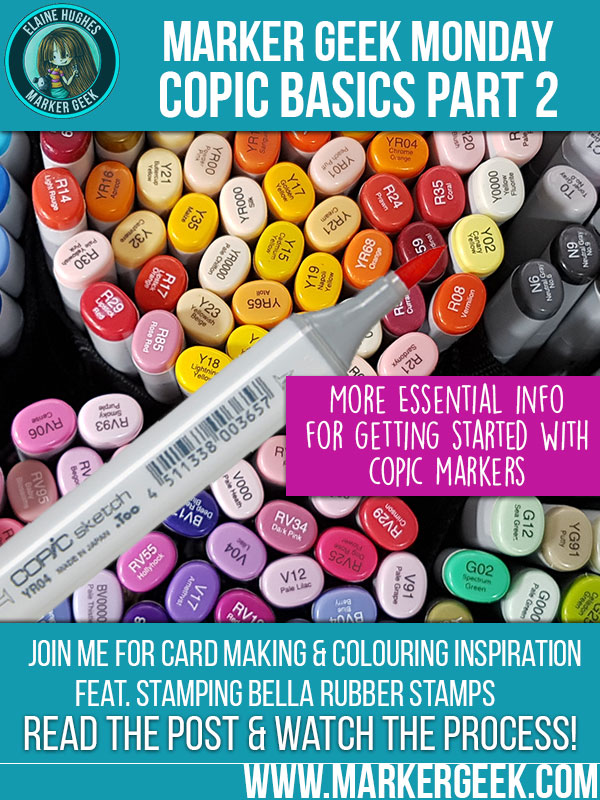Hey everyone, Elaineabella here with this week’s Marker Geek Monday post!
Today we’re following on from last week’s Copic Marker Basics Part 1 post. I’m so glad that at least some of you found it helpful. Hopefully today’s post will prove useful too, either in getting you started or reminding you of some things you may have forgotten!

Last week’s post covered the difference between the various styles of Copic Marker available, some advice on choosing markers and on marker storage. If you missed it or would like to recap, here’s the link: Marker Geek Monday Copic Basics Part 1. My original plan for this week was to discuss marker maintenance and some do’s and don’ts for colouring with Copics. When I sat down to write this post however, I thought it would be better to go over the Copic numbering system and also talk about my most used marker – the Colourless Blender! Next week we will cover marker maintenance etc..
To get started I’d like a brief word about the Copic numbering system, colour combos and blending groups.
The Copic numbering system is pretty straightforward and easy to read once you know what everything represents.
The letters represent the colour family the marker belongs to.
B = Blue BG= Blue Green E = Earth etc.
The first number e.g. B00 represents the saturation level. The lower this number the more vibrant or more saturated the colour tends to be.
The last number e.g. B06 represents the brightness. The lower this number, the lighter the colour will be and vice versa.
Each colour family is broken down into smaller groups based on the first number, so they are divided based on the saturation level. This means that in general the markers in these groups will blend well together. Earth tones tend to behave a little differently.
As mentioned in last week’s post, picking up a few markers from a particular blending group is a great way to start building your collection.
Using the natural blending groups is a great way to get started, learning and practicing colouring and blending with the markers. But in order to get the most from your collection of markers, particularly a smaller collection, think outside the groups! This is where a tool like Sandy Allnock’s Hex Chart comes in very handy indeed. Sandy’s chart groups the colours visually rather than in the more linear fashion of the official Copic chart (which has its own uses – read more about the charts in my Marker Geek Monday: Copic Colour Charts post), because of this it helps you to see colours that may work well together and experiment accordingly!
A good tip when blending markers from different groups is to choose colours with similar levels of saturation. I don’t always do this, but it does make blending easier.
On the Danielle Donaldson Collection – justMaisie image above I used an unconventional blend for the hat: B05,B37,G05. The B05 and G05 play nicely together because they have similar levels of saturation and brightness, and the B37 allowed me to create some nice depth. I talked about this is my recent Marker Geek Monday: Stretch Your Copics post.
When blending trickier combinations, some of the tips in my recent Marker Geek Monday Stretch Your Copics post may come in handy!
There is absolutely no substitute for EXPERIMENTATION! If you want to see if you can get a particular selection of markers to play well together – try them out. The worst that can happen is that you “waste” a little time, ink and paper, but whatever the result, you will have learnt something useful. I always have some scrap paper on my desk for testing things out, and a notebook for making notes.
The Copic Colourless Blender is, to me, an absolute essential. The marker and at least one Various Ink refill in 0 Colourless Blender should be in your Copic collection! I tend to keep at least two refill bottles on hand at any time.
The name “Colourless Blender” is a bit of a misnomer. It doesn’t actually blend the colours together so much as it activates and moves the ink around. Because of this you can use it to “push” colours and lighten areas. How well it works will depend on the paper you use – it will be more effective on some papers than others due to the way the ink moves within the fibres of the paper. Effects will also differ – softer more fibrous papers may give you softer, fuzzier results.
You can see some of the uses mentioned above in action in these previous Marker Geek Monday posts and on my own blog:
And if you would like to see more of one of my favourite techniques featuring Colourless Blender you can check out my more recent blog post: Copic Galaxy and CAS Card.
If you would like to take a look at how I colour using Copic Markers, you can watch some of my colouring videos in the playlist below or over on my YouTube channel.
If you have any Copic tips please share! Especially if you have a great way to store the markers and refills. Let’s talk colour!
If you are posting your images online, we would love to see them on Instagram and all the platforms mentioned above. To make it easier for us to find you just use #markergeekmonday and/or #stampingbella as a hashtag. Even better tag me @markergeek and @stampingbella . We love it when you connect, so don’t be shy!
If you’re on Facebook join us in our private chat group Stamping Bella Sistahood to share your creations there and chat all things Stamping Bella related!
Until next time, HAPPY COLOURING!
MWAH
Elaineabella
Comments are closed.
Thanks so much for the information Elaine! Your tips are always useful! 🙂
Thanks for all the useful info. I am going to refer to all of these posts often.